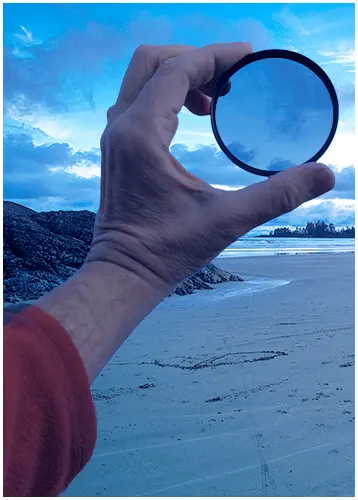
The Charming Northfield Falls in the Heart of Beach Estate Park
Looking to kill off an hour while in Nanaimo, BC? Just a short hop-skip and


As a photographer, I’m always looking for ways to enhance my images. One tool that I’ve found to be incredibly helpful is the polarizing filter, also known as a polarizer. This filter attaches to your camera lens and improves photo quality by reducing reflections and enhancing colours.
Now, you may be wondering what exactly does a polarizing filter do? The filter eliminates unwanted light and reduces reflections and glare selectively. It also helps to enhance the colours in the image, particularly when shooting landscapes or outdoor scenes.
Using a polarizer is especially useful when photographing waterfalls or other reflective surfaces; it reduces or eliminates unwanted reflections. Thus allowing you to capture the true colours and details without any distracting glare.
Therefore, I consider a polarizing filter is an essential piece of gear for any outdoor photo-buff.
When light waves reflect off surfaces, they can become polarized, meaning they vibrate in only one direction. This causes glare and makes it difficult to capture the true colours of a scene in a photograph. A circular polarizer can solve this problem by blocking or allowing only the polarized light.
To achieve the polarizing effect, the filter consists of two layers, one that filters polarized light and one that rotates. The layer that filters polarized light is made of molecules aligned to block light waves that vibrate in one direction. By adjusting the rotating layer, it becomes possible to align it with the direction of the polarized light waves, effectively enabling the selective filtering or passage of specific wavelengths.
The polarizing effect is strongest when the filter is rotated 90 degrees from the angle of the reflected light. By rotating the polarizer, you can reduce glare and annoying reflections, resulting in crystal-clear views of the scene. Moreover, it intensifies the richness of colours and enhances the sharpness of contrasts. This effect is particularly useful in landscape photography, where it can bring out the colours of foliage and sky.
If you’re looking to take your photography to the next level, using a polarizing filter is a must. This simple yet effective tool can improve the quality of your images by reducing haze and glare and enhancing colour saturation and contrast. With a polarizing filter, you can capture more vivid and vibrant scenes that pop.
One of the main benefits of using a polarizing filter is the reduction of haze. When taking photographs outdoors, haze can be a significant problem, especially on hot and humid days. This can cause images to appear soft and lacking in detail. By using a polarizing filter, you can cut through the haze and capture sharper, more defined images.
Another significant advantage of using a polarizing filter is the reduction of glare. Glare can be a challenging issue when photographing reflective surfaces, such as water or glass. It can create distracting reflections that can detract from the image. By using a polarizing filter, you can eliminate glare and capture clearer, sharper images.
Using a polarizing filter can also enhance colour saturation and increase contrast. When shooting landscapes or nature scenes, a polarizing filter can make the colours appear more vivid and vibrant. It can also increase contrast and make the image pop, adding depth and dimension to the final result.
When using a polarizing filter, it is essential to ensure it is compatible with your camera lens. Some lenses may require a specific type of polarizer, such as a circular polarizer, to work effectively. It’s also crucial to adjust the filter’s rotation to achieve the desired effect. Typically, rotating the filter between 30 and 90 degrees will provide the optimal amount of polarization without compromising image quality.
Using a polarizing filter can significantly enhance the quality of your photographs. By positioning the filter in front of the camera lens, it purposefully obstructs specific light waves from reaching the lens, thereby reducing both the intensity of light and unwanted reflections. This method helps to increase the saturation and contrast in your photos.
The following steps will help you master the technique of using a polarizing filter:
Mastering the proper use of a polarizing filter takes practice and experimentation. But once you’ve mastered the technique, you’ll be amazed at the difference it can make in your photos. Rotate the filter before taking the photo to adjust the polarized light. This helps control the amount and direction of light entering the lens for better results.
When it comes to choosing the right polarizing filter for your photography needs, there are a few factors to consider. From the type of polarizer to the shooting situation, here are some key considerations to keep in mind:
There are two types of polarizing filters: linear and circular polarizers. Linear polarizers are an older technology and can interfere with modern autofocus systems. It is recommended to use a circular polarizing filter for most DSLR and mirror-less cameras to avoid this issue.
When shopping for a polarizing filter, make sure it is compatible with your camera’s autofocus system. Some older linear polarizers may disrupt autofocus, while newer circular polarizers are designed for compatibility with autofocus systems.
Neutral density filters are used to reduce the amount of light that enters the camera lens. This allows for longer exposures in bright conditions. ND filters are useful in landscape photography, especially for capturing the motion blur effects of waterfalls or clouds.
The type of polarizing filter you choose will also depend on the shooting situation. For landscape photography, it’s best to use a circular polarizer. However, for other types of photography where autofocus isn’t needed, a linear polarizer can also work. Consider the lighting conditions, the type of scene you are shooting, and the desired effect when selecting a filter.
Consider these factors when choosing a polarizing filter.
Using a polarizing filter can be a bit tricky at first, but with practice, you’ll quickly master the technique. Here are some tips and tricks to help you get the most out of your polarizing filter:
Before using a polarizer filter, it’s important to understand what polarized light is. When light reflects off non-metallic surfaces such as water, glass, or foliage, it becomes polarized. This means that the light waves align in a specific direction, causing glare and reflections. A polarizing filter can selectively block or allow polarized light, reducing glare and enhancing colours in your photographs.
Polarizing filters work best when the light source is perpendicular to the subject. If the light source is directly behind or in front of the subject, the filter won’t have much effect. To get the desired result, rotate the polarizing filter until you see the effect you’re looking for. Avoid rotating the polarizing filter excessively, as this can decrease the amount of light entering the lens. Consider the desired amount of light for each shot.
A circular polarizer filter is the most common type of polarizing filter used in photography. Unlike linear polarizers, circular polarizers are designed to work with autofocus and metering systems in modern cameras. To use a circular polarizer filter correctly, ensure that it fits your camera lens and adjust its rotation until you achieve the desired effect.
A filter holder can be useful when using polarizing filters. By attaching the filter to the holder, you can easily rotate it without physically touching the lens. Reducing the risk of smudging or scratching the lens and allowing for precise adjustments to the filter angle.
Don’t be afraid to experiment with different angles when using a polarizing filter. The angle of the filter and the position of the light source can create various effects in your photos. Try rotating the filter to 90 degrees from the light source to enhance colours, or at 180 degrees to remove glare and reflections.
When using a circular polarizer filter, you can rotate the filter to control the degree of polarization. By rotating the filter, you can adjust the intensity of the polarizing effect and reduce reflections. For example, when photographing water or glass, rotating the polarizing filter can eliminate unwanted reflections and enhance colour saturation.
Remember to be mindful of the direction of the light when rotating the polarizing filter. The most effective results are achieved when the filter is perpendicular to the direction of the light source. Rotating the filter won’t make a big difference on the polarizing effect if the light is coming from either behind or in front of you. With a bit of practice and experimentation, you’ll be a pro at using polarizing filters in no time!
Pro-Tip: Avoid always rotating a circular filter in one direction. It will become too tight on the lens, and you will not be able to remove the filter.
Pro-Tip2: If the filter is tight to remove. Try using wrapping a rubber band on the filter to get a better grip
In conclusion, I highly recommend using a polarizing filter in your photography. Without a polarizing filter, it can be difficult to control the reflections, which can lead to dull images. However, by rotating the polarizing filter, you can adjust the intensity of the polarizing effect and enhance your shots.
Use these tips and tricks to make the most of your polarizing filter and take amazing photos with less glare and more vibrant colours. Remember to experiment with different angles and techniques to find the best results for your specific photography needs.
A polarizing filter in photography reduces reflections and enhances the vibrant colours of the subjects. It reduces glare and reflections on surfaces like water or glass for clearer and more vivid images.
The process of polarization pertains to the selective obstruction or allowance of polarized light. A polarizing filter consists of molecules that can absorb light waves oscillating in a specific direction, reducing their intensity. Rotating the filter adjusts the polarization effect, helping you control reflected light in a scene.
Using a polarizing filter offers several advantages for photography. It can reduce haze and glare, enhance colour saturation, and increase contrast. Additionally, it can improve the overall clarity and depth of your shots, making them more visually appealing.
To use a polarizing filter, you simply attach it to the front of your camera lens. By rotating the filter, you can adjust the polarization effect to achieve the desired results. It’s important to experiment with different angles and intensities to find the best settings for each scene.
There are two main types of polarizing filters: linear and circular. Linear polarizers work well with manual focus cameras, while circular polarizers are designed for use with autofocus cameras. Choose the right filter for your camera and shooting needs based on each type’s specific applications and considerations.
Pairing your polarizing filter with neutral density filters will optimize its advantages, giving you full control over the amount of light that enters your lens. Learn about polarized light and how it interacts with subjects to capture unique images.
When using a polarizing filter, always remember to rotate the filter to achieve the desired effect. Experiment with different angles and intensities to find the best results. Also, consider the specific needs of your camera and shooting situations when choosing the right filter.

Looking to kill off an hour while in Nanaimo, BC? Just a short hop-skip and

Photography can be a fulfilling and enjoyable hobby that brings a creative outlet to your

Welcome to our guide to Photoshop tutorials for beginners: A Complete Beginner’s Tutorial for Learning